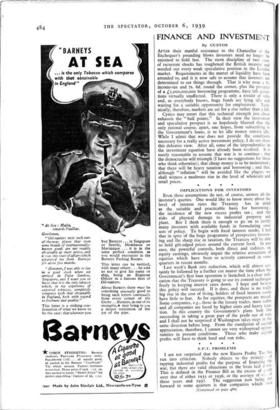IMPLICATIONS FOR INVESTORS
Even these assumptions do not, of course, answer all the investor's queries. One would like to know more about the level of interest rates the Treasury has in mind as the suitable and practicable basis for borrowing ; the incidence of the new excess profits tax ; and the risks of physical damage to industrial property and plant. But I think there is enough to go on to justify many investors with available funds in formulating some sort of policy. To begin with fixed interest stocks, I feel that in spite of the huge programme of prospective borrow- ing and the sharp rise in taxation, the Treasury will be able to hold gilt-edged prices around the current level. In any case, the powerful controls, both direct and indirect, on equity earnings, obviously impair the relative attractions of equities which have been so actively canvassed in some quarters in recent months. Last week's Bank rate reduction, which will almost cer- tainly be followed by a further cut nearer the time when the Government's first loan operation is launched, is a clear indi- cation that the Treasury is going to use its control technique freely in keeping interest rates down. I hope and beieve this policy will succeed. If it does, and there is no really big rise in the cost of living, holders of fixed interest stocks have little to fear. As for equities, the prospects are mixed. Some companies, e.g., those in the luxury trades, must suffer and all companies are faced by higher costs and heavy taxa- tion. In this country the Government's plans look like succeeding in taking a great part of the profit out of war, and I shall not be surprised if Washington takes steps in the same direction before long. From the standpoint of capital appreciation, therefore, I cannot see very widespread oppor- tunities in present conditions. Those who make capital profits will have to think hard and run risks.


































 Previous page
Previous page